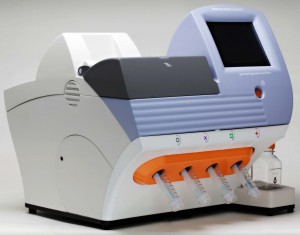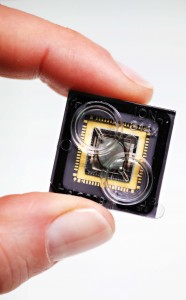![]()
In the last session of AGBT 2010, new player Ion Torrent impressed the crowd with a low-cost sequencing platform that uses a silicon chip to sequence DNA. The principle, for once, is easy to understand: a silicon chip printed with millions of tiny semiconductor wells. In each well, when DNA polymerase adds a base to the template strand, a hydrogen ion is released. It hits a pH detector in the bottom of the well, and the pH change is recorded digitally. Multiple incorporations cause linear increases in the pH change, so homopolymers should be less of a problem than 454. It operates on native DNA, without any of the reagents, dyes, and other complicating aspects of other sequencing technologies.
 So, can I take a picture of that?
So, can I take a picture of that?
During my tour of the Ion Torrent suite, I saw just how simple and straightforward the machine was.
It’s slightly larger than a bread box. When opened, it’s little more than a motherboard with a few wires running into it. The real engineering marvel is the semiconductor chip itself (below left), which is tiny and packed with about 1.5 million pH-sensitive wells.
It seems to me that the chip and the motherboard are the heart of the instrument, so obviously, I asked if I could take a photo. The Ion Torrent representative, a Mr. Garrick, politely (and obviously) said that I could not.
However, to their credit: within hours, I had an e-mail from IonTorrent’s PR agency providing me with some exclusive photos of the equipment. They’re scattered throughout this post. I actually can’t guarantee that they’re exclusive, but I was happy to have something.
Post-Light Sequencing with Semiconductor Chips
Jonathan Rothberg, CSO of Ion Torrent, gave the final presentation of AGBT 2010. In my opinion, which was shared by several attendees, the talk was a disappointment.

Rothberg is obviously a brilliant guy, but he lacks the polish of Eric Schadt (PacBio) and Joseph Beecham (Life Tech), who gave talks right before him.
Instead, the speaker went on and on about the $90 billion investment in the semiconductor industry that enabled the design of the IonTorrent chip, which can be manufactured in virtually any CMOS facility. This is an important strength for the technology, because competition among manufacturers will drive the cost down.
He called it “Steve Jobs meets Gordon Moore” and in some ways he’s right – Ion Torrent may very well make sequencing accessible to just about everyone. But Rothberg failed to mention a few salient points concerning the Ion Torrent technology, and he shrugged off an attendee’s question about sample prep (“If I tell you about that, you won’t come to my next talk.”).
Not the answer the audience wanted.
IonTorrent: What You Need To Know
What I learned in the Ion Torrent suite impressed me far more than Rothberg did. The most salient points were:
- Low cost. The instrument is tentatively priced at $45K, and disposables (chips) are $500 per run.
- Throughput. The standard chip, called the 314, contains 1.5 million wells. It’s one read per well, but importantly (and glossed over by Rothberg), they expect ~50% of wells to be filled. That’s 750,000 reads; at the current read length (100 bp), we’re talking 75 Mbp per run.
- Run time. The claim is one hour, but conversations with people who run the instrument reveal that it’s more like two hours. That’s still a very quick turnaround. No word on whether run time will increase with longer reads.
- Coming improvements. There’s already a new chip design (the 316) which packs in 7.3 million wells, more than quadrupling the sequence throughput. Ion Torrent representatives continually assured me that, to this point, they’ve only focused on getting the machine to work, and haven’t yet begun to tweak the chemistry or other aspects that could improve performance.
- Ipod and app included. I can’t believe that Rothberg didn’t mention this – an iPod Touch ships with each instrument, pre-installed with an app to monitor runs and cycles in real time. How cool is that?
Many at AGBT, like me, were less excited about IonTorrent immediately after Rothberg’s talk. However, hours later, the excitement seemed to work its way up. Aaron Quinlan (UVA) said that he was impressed because this is a technology that a small lab can write an R01 grant around. Vince Magrini (WashU) wondered if the CSHL sequencing course might one day feature one IonTorrent instrument per student. Ion Torrent certainly has a niche pretty much to themselves, so I think this is a company to watch.
 laine Mardis, who presented WashU’s pipeline for detecting and validating somatic mutations from whole-genome sequencing. Our pipeline has evolved over the course of AML1, AML2, and other cancer whole-genome sequencing projects, and now has the highly automated capacity to handle the coming 600 tumor-normal pairs to be sequenced for the
laine Mardis, who presented WashU’s pipeline for detecting and validating somatic mutations from whole-genome sequencing. Our pipeline has evolved over the course of AML1, AML2, and other cancer whole-genome sequencing projects, and now has the highly automated capacity to handle the coming 600 tumor-normal pairs to be sequenced for the 